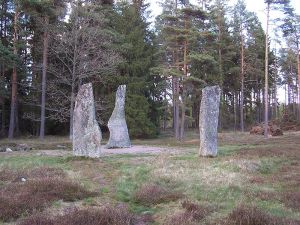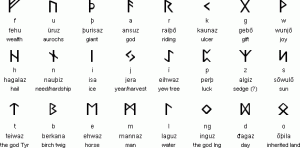One of Sweden’s great mysteries surrounds a monolith called the Björketorp Runestone (DR 360 U)(Pronounced Bee-york-kuh-torp). The nearly 14 foot (4.2 meters) stone is located in Blekinge, Sweden, and forms a stone circle with two other blank menhirs, with several other solitary stones in the surrounding regions. It is covered in a Proto-Norse language of Runes which contain a foreboding warning about the stone. One side of the stone reads:
“I, master of the runes, conceal here runes of power. Incessantly (plagued by) maleficence, (doomed to) insidious death (is) he who breaks this (monument).”
The runes on the other side of the stone translate to “Prophecy of Destruction” or “Prediction of Perdition”, which may be in reference to a warning pertaining to the stone’s destruction. In other words– my words– Don’t attempt to destroy this stone or you will surely die.
The runic markings on the stone, made sometime around the 6th or 7th century, are consistent with Elder Futhark Runes– the oldest form of the runic alphabet, which was used by Germanic tribes between the 2nd and 8th centuries. The name “Futhark” comes from the first six rune names– F, U, Th, A, R, and K. This runic alphabet also contains twenty-four runes, which are most often expressed in three rows, or groupings called ætts (pronounced “eats”), of eight. This written language was later replaced by the more simplified version called Younger Futhark. As Younger Futhark became more predominately used, people forgot how to read Elder Futhark. Norwegian scholar Sophus Bugge, was able to decipher the Elder Futhark runes in 1865, bringing a lost language back to life and making the translation of the Björketorp Runestone possible.
Many scholars disagree on the purpose of the Björketorp Runestone, though most of those theories relate to some form of marker or shrine. Some scholars have suggested that it is an ancient border marker between the Swedes and the Danes. It has also been thought to have been a fertility shrine or a shrine honoring the Norse god, Odin (All Father). Probably the most predominant theory surrounding the purpose of the monolith is that it was a burial marker, either for a real grave or as a memorial, which necessitated the use of a prophetic warning to prevent the stone’s removal; An archaeological investigation of the area conducted in 1914 did not reveal the presence of any human remains, so the purpose of the stone is still under speculation. Even though the purpose of the stone is unknown, the stone’s mysterious curse seems to be real… at least according to local legend.
When the stone was thought to be an impediment to the land, which a local man desired to cultivate, its removal was attempted. On a day of calm weather and with no winds, the local man piled wood around the stone, so he could heat the stone and then crack it by pouring cool water over the stone’s surface. As the man set fire to the wood surrounding the stone, a gust of wind blew the flames away from the stone and towards the man, setting his hair on fire, and extinguishing the blaze around the Björketorp Runestone. The man, unable to quench the flames, died in terrible, flaming agony.
Whether you believe the story of the curse or not, the stone’s cryptic message and the local legend surrounding it still gives one pause– Why is the Björketorp Runestone still standing after over 14 centuries?
Sources:
* http://enjoysweden.se/en/object/bjorketorp-runestone/
* http://listverse.com/2007/10/11/top-10-bizarre-curses/
* http://en.wikipedia.org/wiki/Bj%C3%B6rketorp_Runestone
(Photo Source– Rights Released under Creative Commons)
* http://en.wikipedia.org/wiki/Elder_Futhark
(Taken with a grain of salt…)


